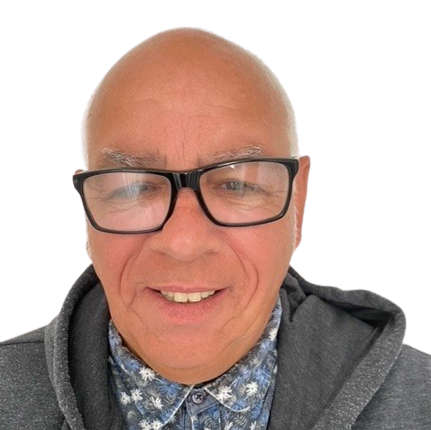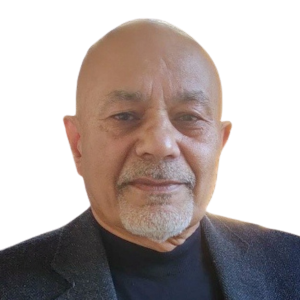In front of me, there is a building that has collapsed upon itself, six floors piled upon each other.
A wild dog is walking through its ruin, while a military drone buzzes above. In the distance, there is the cackle of machine gun fire.
Welcome to Shuja'iyya, in the north of Gaza. Not so long ago, this was a bustling town of around 100,000 people, proud of a history dating back 850 years.
Now, it is a wasteland, a patchwork of dust and misery.
Israel does not allow news organisations to report independently from Gaza. Today, it took a group of journalists, including Sky News, into the area of the Strip occupied by Israeli forces.
The brief visit was highly controlled and offered no access to Palestinians, or other areas of Gaza. Military censorship laws in Israel mean that military personnel were shown all our material before publication.
Sky News maintained editorial control of this report at all times.
The buildings in front of me have all been wrecked by warfare - at best, the sides blown out and a mere skeleton remaining. Many have simply been reduced to rubble.
Over the past two years, more than 68,000 people have been killed in Gaza as a result of Israeli military action. It was a war that started on 7 October 2023, when more than 1,200 people, mostly civilians, were killed by Hamas militants in a devastating surprise attack.
Now, an uneasy ceasefire hangs over Gaza, the result of the peace plan drawn up by US President Donald Trump's team and now endorsed by the United Nations.
I am standing on a mound of earth at the edge of an Israeli military camp. The only signs of life around me are the Israeli soldiers behind me, a roster of wild dogs who dart around the area, and a single solitary bird that lands on a rock - a gentle counterpoint to the desolation that surrounds it.
This is the Israeli side of the line that now divides Gaza into two parts. It's known as the Yellow Line, although there is no actual line running through the whole territory.
A series of concrete blocks are gradually being put into place, but they are starting from the edges and working in.
From where I'm standing, I can see a tall red and white mast several hundred metres away. This sits exactly on the Yellow Line, so it is a very visible sign that we are near the division.
Basically, the land I'm standing on is now run by Israel, and is home to a very small number of Gazans. The vast majority of the two million-strong population is on the other side of the Yellow Line, where control is still held by Hamas.
The Israeli military has invited us here. They are in charge of where we go and what we see, and they also have the right to censor the material we broadcast, although we, as journalists, retain complete editorial control over what we write and say.
IDF: Hamas 'haven't changed who they are'
The message they are keen to project is that, despite two years of attacks on Gaza, Hamas has not gone away and is showing no sign of disarming.
And that, they insist, is something that worries all Israelis, and terrifies those who live near the border with Gaza. Some of those towns are very clearly visible through the afternoon haze.
"We're not staying here as a hobby," says Lieutenant Colonel Nadav Shoshani, the spokesperson for the Israeli Defence Forces (IDF).
"We're staying here to secure the people of Israel. We see it right there," and he points towards a nearby Israeli town.
"It's a two-minute drive to where our civilians live. And we see right here a battlefield where there were tens of thousands of Hamas terrorists.
"They haven't changed who they are. And it's going to need pressure from the international community and maybe also from Israel to make sure they disarm.
"Hamas are rearming, Hamas are killing their opponents on the street. Hamas are trying to reassert dominance, and power, in Gaza."
Under the peace plan endorsed by the UN, a so-called stabilisation force is expected to enter Gaza to protect civilians and ensure the delivery of humanitarian aid.
But we have no details of who those troops will be, when they will arrive, what their legal mandate will be or whether they will be required to disarm Hamas.
For the moment, the Strip is simply split between the half where there is a strictly-enforced peace, but almost no residents, and the half where there are millions of people trying to live amid the chaos of post-war devastation.
International journalists are now allowed into Gaza, but our colleagues have been there since the start of the war.
As I was watching Shuja'iyya from an Israeli army camp, so they were visiting the remains of the town on the other side of the Yellow line.
Read more:
Trump's Gaza plan looks convincing - but there's more to this story
Inside warehouse where Gaza aid held after Israel 'refused entry'
'Everything here is destroyed'
What they saw was the same vista of ruin. It is impossible to imagine people living in such a place, but remarkably, some do.
Our team met Iman Hasoneh, 48 years old, and ground down by the pain of life.
Her husband has internal bleeding from a wound, and her children are exhausted. The family fled Shuja'iyyah months ago, then found nowhere else to live, and ended up returning to the rubble of their home.
"Our home collapsed, and it was a miracle we escaped," she says. "We couldn't find anywhere else. Our struggle was immense. We moved around so much.
"There was a rocket attack over there" - she beckons towards another collapsed building down the street - "and the blast knocked us all over.
"I didn't expect to survive. I'm giving up. One day they will just announce that we have all been killed. We are on the edge of the Yellow Line, and there is so much suffering."
Our team asks here about the effect of the peace plan.
"I want to be optimistic, but I'm not sure what is going to happen.
"They are giving us an anaesthetic to numb the pain. But everything here is destroyed. God willing, the Israelis will pull out and leave here."
Above her, the drone is buzzing.
It is the same drone we heard from the camp, launched from near the place where I stand and watch, now hovering over the ruined home where Iman hopes to live another day.

(c) Sky News 2025: 'Patchwork of dust and misery': At the Yellow Line dividing Gaza - where all t


 A Bond-villain ship prowling our waters: Why the Yantar alarms the West
A Bond-villain ship prowling our waters: Why the Yantar alarms the West
 UK weather: Amber and new yellow Met Office warnings in place as parts of UK hit by heavy snow
UK weather: Amber and new yellow Met Office warnings in place as parts of UK hit by heavy snow
 Former Met Police officer David Carrick found guilty of more sexual offences
Former Met Police officer David Carrick found guilty of more sexual offences
 Driving test changes announced - with more focus on faster and rural roads to cut deaths
Driving test changes announced - with more focus on faster and rural roads to cut deaths
 Oasis fan fell to his death at Wembley in 'tragic accident', coroner's court hears
Oasis fan fell to his death at Wembley in 'tragic accident', coroner's court hears
 New record for wind-powered electricity in Britain
New record for wind-powered electricity in Britain
 Meta to block Instagram and Facebook for users under 16 in Australia
Meta to block Instagram and Facebook for users under 16 in Australia
 'One of the greatest nights in Scottish football': A nation revels in World Cup success
'One of the greatest nights in Scottish football': A nation revels in World Cup success








